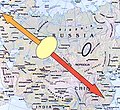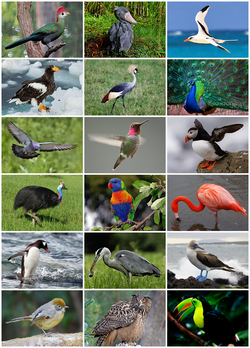Reverse migration, also called reverse misorientation, is a phenomenon whereby a bird migrates in the opposite direction to that typical of its species...
13 KB (1,636 words) - 01:58, 26 August 2024
Reverse migration may refer to: Reverse migration (birds), a phenomenon in bird migration Reverse migration (immunology), the phenomena during inflammation...
224 bytes (55 words) - 07:28, 7 August 2023
Bird migration is a seasonal movement of birds between breeding and wintering grounds that occurs twice a year. It is typically from north to south or...
98 KB (11,141 words) - 05:49, 29 May 2025
migration is the phenomenon in which migrating birds are blown off course by the winds while they are in flight. It is more likely to happen to birds...
1 KB (199 words) - 05:03, 5 September 2022
"perching" birds. Birds have wings whose development varies according to species; the only known groups without wings are the extinct moa and elephant birds. Wings...
225 KB (23,631 words) - 02:20, 28 May 2025
Birds of prey or predatory birds, also known as (although not the same as) raptors, are hypercarnivorous bird species that actively hunt and feed on other...
49 KB (5,081 words) - 14:45, 23 May 2025
Fish migration is mass relocation by fish from one area or body of water to another. Many types of fish migrate on a regular basis, on time scales ranging...
27 KB (2,873 words) - 21:22, 27 May 2025
Vagrancy (biology) (redirect from Vagrancy in birds)
Northwest Europe, e.g. Arctic warblers in Britain. This is reverse migration, where the birds migrate in the opposite direction to that expected (say, flying...
7 KB (812 words) - 17:22, 21 May 2025
Sea turtle migration is the long-distance movement of sea turtles (superfamily Chelonioidea), comprising the swimming of adults to their breeding beaches...
26 KB (3,304 words) - 13:41, 23 May 2025
Cuckoo (redirect from Cuckoo bird)
are medium-sized birds that range in size from the little bronze cuckoo, at 17 g (0.6 oz) and 15 cm (6 in), to moderately large birds, ranging from 60–80 cm...
57 KB (6,344 words) - 19:02, 28 May 2025
Mourning dove (redirect from Mourning bird)
most abundant and widespread North American birds and a popular gamebird, with more than 20 million birds (up to 70 million in some years) shot annually...
37 KB (4,088 words) - 00:46, 24 May 2025
Weather radar (redirect from Doppler radar and bird migration)
precipitation. It can track bird migrations as well (non-weather targets section). The radio waves from the radars bounce off rain and birds alike (or even insects...
106 KB (12,857 words) - 16:10, 31 May 2025
surface for the night, then migrating to depth again around dawn. Reverse migration occurs with organisms ascending to the surface at sunrise and remaining...
43 KB (5,187 words) - 23:07, 22 May 2025
V formation (category Bird migration)
improves the efficiency of flying birds, particularly over long migratory routes. It is hypothesized that the birds after can take the upwash lift force...
13 KB (1,443 words) - 12:31, 10 April 2025
birds reared from hatching by humans. Such birds are called "imprints" in falconry. When an imprint must be bred from, the breeder lets the male bird...
19 KB (2,303 words) - 19:20, 11 March 2025
Chain migration is the social process by which immigrants from a particular area follow others from that area to a particular destination. The destination...
25 KB (3,291 words) - 19:32, 11 February 2025
Bantu expansion (redirect from Bantu migration)
Bantu-speaking groups through correlation of location and language group. The migrations of the original Proto-Bantu-speaking group, spread from an origin around...
41 KB (4,023 words) - 16:19, 31 May 2025
Painted bunting (category Native birds of the Plains-Midwest (United States))
short to medium distances. Western birds (Arizona and northern Mexico) molt in mid-migration, while eastern birds tend to molt before they migrate. Painted...
22 KB (2,381 words) - 15:46, 3 April 2025
Cooper's hawk (category Birds of prey of North America)
many birds of prey, the male is smaller than the female. The birds found east of the Mississippi River tend to be larger on average than the birds found...
265 KB (37,374 words) - 19:22, 24 May 2025
Urbanization (redirect from Rural-urban migration)
settlements around the downtown area, the so-called in-migration. In-migration refers to migration from former colonies and similar places. The fact that...
96 KB (10,913 words) - 13:38, 24 May 2025
Goldcrest (category Birds of Eurasia)
birds on the Isle of May in October 1982, and nearly 21,000 birds through a single site in Latvia during September and October 1983. Spring migration...
68 KB (7,859 words) - 15:06, 5 April 2025
Red knot (category Birds of the Arctic)
to the southern tip of South America and repeats the trip in reverse. The exact migration routes and wintering grounds of individual subspecies are still...
40 KB (4,540 words) - 12:26, 25 May 2025
Snow goose (category Birds of the Arctic)
than half the year on their migration to-and-from warmer wintering areas. During spring migration (the reverse migration), large flocks of snow geese...
23 KB (2,674 words) - 23:44, 6 January 2025
African pitta (category Birds of Africa)
confirmed the timing of northwestward migration. Exhausted and perished birds are regularly found during migration, especially November to December and...
14 KB (1,470 words) - 17:21, 11 October 2024
study scientifically in birds. In general, birds have relatively large brains compared to their head size. Furthermore, bird brains have two-to-four times...
55 KB (6,751 words) - 16:16, 29 May 2025
Common crane (category Birds of Eurasia)
social bird while not breeding. Flocks of up to 400 birds may be seen flying together during migration. Staging sites, where migrating birds gather to...
42 KB (4,666 words) - 07:08, 19 May 2025
Rough-legged buzzard (category Holarctic birds)
of winter, Rough-legged buzzards begin their return migration, retracing their route in reverse. The slow phase occurs first, as they move northeastward...
35 KB (4,014 words) - 19:47, 27 May 2025
Manx shearwater (category Birds of the Atlantic Ocean)
Juvenile birds undertake their first migration without their parents. Only a few days after leaving the nest, these birds can already travel up to 2000 km...
34 KB (3,702 words) - 16:44, 24 May 2025
terms used in the description of birds—warm-blooded vertebrates of the class Aves and the only living dinosaurs. Birds, who have feathers and the ability...
289 KB (31,068 words) - 06:57, 2 March 2025
Steppe eagle (category Birds of Central Asia)
(2011). Autumn migration of soaring birds through the Gebel El Zeit Important Bird Area (IBA), Egypt, threatened by wind farm projects. Bird Conservation...
171 KB (24,153 words) - 06:51, 13 April 2025


























